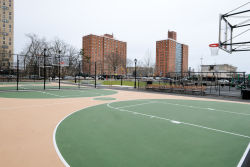What was here before?
Coney Island’s name may derive from the Dutch word for rabbit, since the island was full of “konijn,” or wild rabbits, during the 1600s. In 1829 the Coney Island House became its first seaside resort, and within a few decades the enclave was hosting an increasing stream of visitors. After the Civil War, new railroad lines provided direct public transportation to a rapidly expanding list of attractions: restaurants, hotels, bathing pavilions, shops, amusement rides, racetracks, and theatres. At the turn of the century, amusement parks—Sea Lion Park, Steeplechase Park, Luna Park, and Dreamland—offered rides, concessions, and entertainment on a spectacular scale.
When the Brooklyn-Manhattan Transit (BMT) subway line reached the area in 1920, the pleasures of Coney Island were just a five-cent ride away from the steaming city. Attendance on a hot summer day could reach hundreds of thousands.
Show Disclaimer
Highlights
Check out your park's Vital Signs
Clean & Safe
Green & Resilient
Empowered & Engaged Users
Share your feedback or learn more about how this park is part of a
Vital Park System














